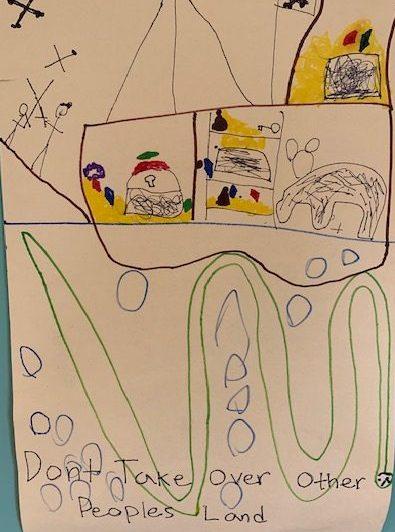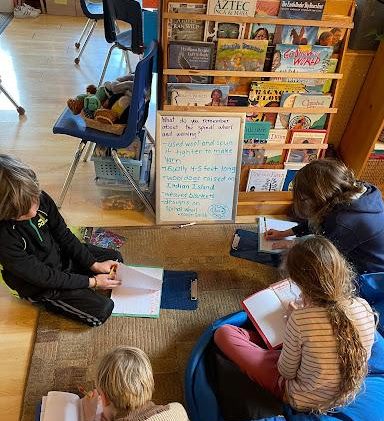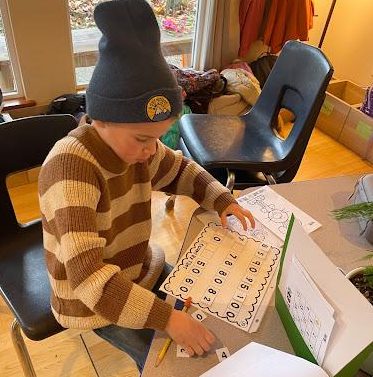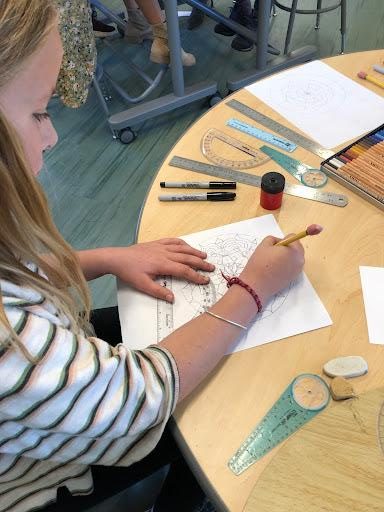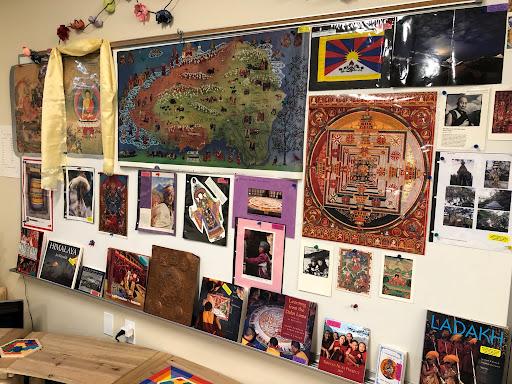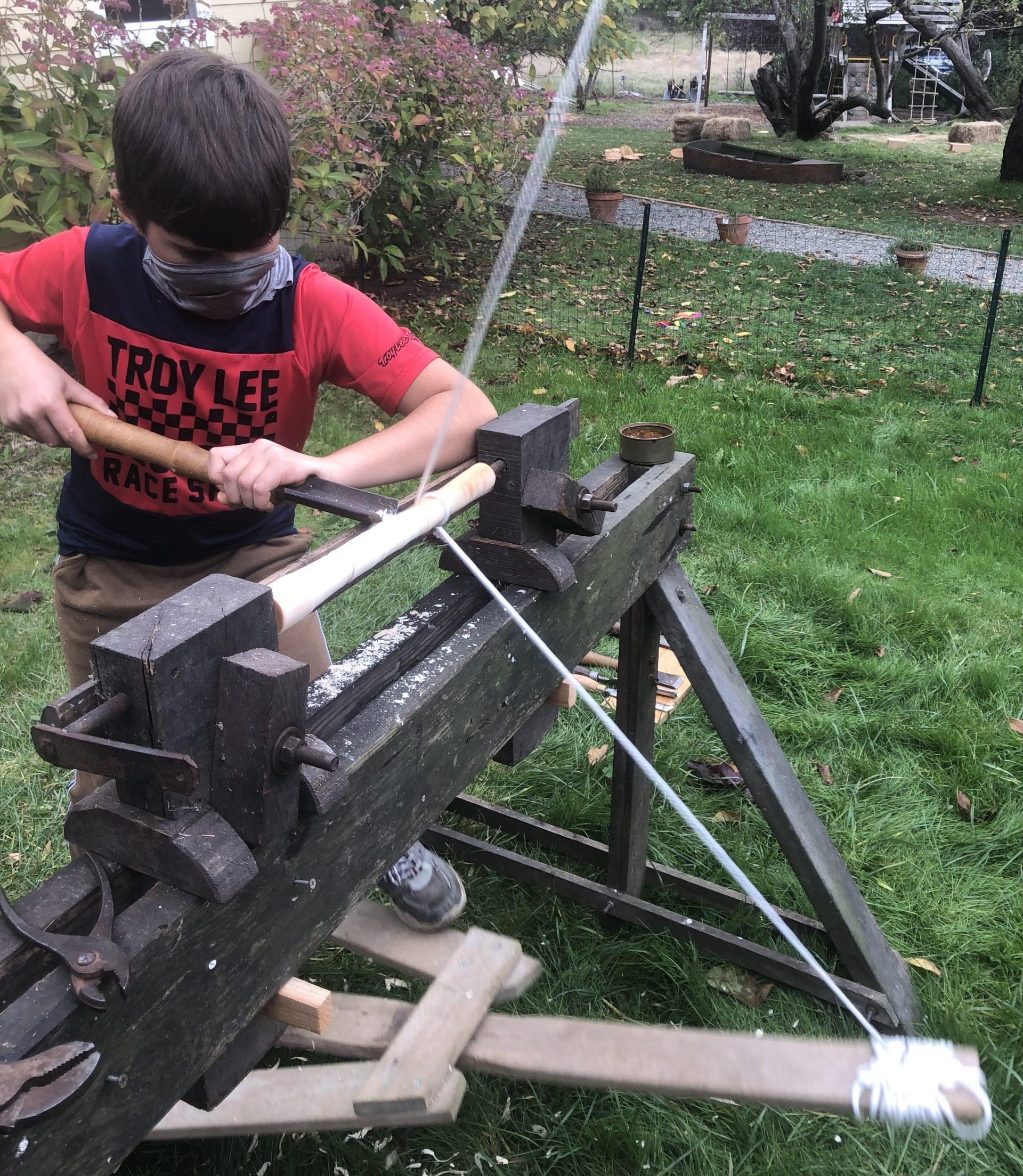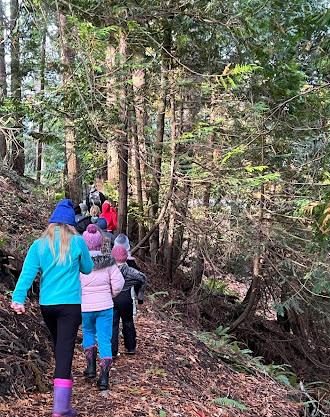Elementary (Otters, Cedars & Eagles) Program
Passionate learning, inspired community
Salmonberry’s elementary program provides an outstanding holistic education. Students realize their potential as active and engaged learners. They become aware of themselves as unique individual beings and effective community members, sensitive to the needs of the world around them.
They learn values of compassion, empathy, justice and care. They develop strong skills in all academic areas and are eager to use them. Salmonberry students see their learning as meaningful and relevant. They are fully prepared and excited to continue on a lifelong learning adventure. They understand that the journey of education is about entering a shared dialogue and making the most of their capacities for insight, imagination, creativity and critical thinking to make this world a better place.
The Salmonberry Elementary program serves children ages 6-12 years old and is divided into three classrooms. The Otters class typically aligns with grades 1-2, serving six and seven year olds. The Cedars class serves ages 8 and 9, and the Eagles group serves 9-12 year olds. Each program uses an integrated thematic approach to provide meaningful learning experiences to each of the three classrooms’ multi-age learners.
Guiding Principles
Students are offered a strong academic program, which is designed to meet the unique needs and learning styles of each child. The student:teacher ratio is low, and the learning community is intimate and nurturing. It is creative and dynamic with students afforded opportunities for experiential learning within their Salish Sea home and far beyond. Teachers make an explicit effort to ensure that students of all genders, races, and backgrounds feel welcome and included. In both curriculum design and methods, teachers pay close attention to the imperative of working towards a shared vision of social justice. Attention to children’s social and emotional growth and development are important pieces of Salmonberry’s elementary program. Teachers maintain high expectations for students in all areas and work one to one to draw out exceptionally high quality, thoughtful and beautiful work. Be it art, dance, writing, or applied mathematics, students are challenged to do their best. This is reflected in behavioral expectations, social awareness, and working for academic excellence.
Elementary Programs
Otters, ages 6-7
The Salmonberry elementary journey begins in the Otters class at the intersection of play and academics. Significant emphasis is placed on guiding students to become more aware of their context and make appropriate choices within it. Students use choice time to engage with art projects, construction projects,and many other imaginative explorations. Additional importance is placed on the child’s responsibility to their friends and the community as a whole. Community is a very important piece of Otter-hood as children practice compromise, collaboration, and negotiation in different sized social groupings.
The Otters classroom is rich in literacy. Students write a lot! Daily lessons are taught in phonemic awareness and developing word-attack skills. Invented spelling and other developmentally appropriate steps along the path towards literacy are valued parts of the learning journey. Teachers prioritize writing both as communication and as creative expression. Students participate in writers’ workshops, with ongoing individual writing support. They receive one-to-one reading instruction with their teachers. Together the Otters celebrate literacy and feel pride by publishing original classroom books.
Numeracy is often introduced through play with manipulatives that can build awareness of many strands of math from geometry to measurement, but writing numbers conventionally and counting forwards and backwards by ones, fives and tens are also important parts of the program. Math units are often based on the emergent interests of the students. For example, telling time and money work, emphasize honing basic math skills like simple operations, one to one correspondence, and number patterns.
Otters students are encouraged to find their own challenge level and voice areas of particular interest. Teacher-designed activities are often accessible to multiple skill levels. Projects emerge out of authentic student encounters and areas of curiosity. We find that Otter children stretch themselves and do their best work when they are fully engaged in a topic of interest, so we sometimes adjust plans to take advantage of interests and opportunities that come our way.
Cedars, ages 8-9
In our Cedars program, students develop autonomy and shared community responsibility. With their teachers’ guidance, students create a set of classroom agreements near the start of the school year. These shared expectations emerge from deep discussions within a whole group setting and set the foundation for classroom norms and behavior. Students learn the skills and processes to lead the daily class meeting with support by the teachers. Students have rotating class jobs and responsibilities, which afford them opportunities for leadership and help them to feel ownership within their class.
Social and emotional learning is a cornerstone concept for this age group. Cedars teachers model and prioritize practices around self-regulation and turn taking as well as fairness & conflict resolution. Cultivating empathy and honesty, and differentiating needs versus wants is a central focus. Students set personal goals while maintaining shared ownership of the success of the class as a whole.
Cedars academics provide an opportunity for more differentiated instruction. Depending on the needs of the lesson, instruction is offered in whole group, small group, partner, and individual settings. During Math and Literacy blocks, students are often divided into one of two instructional groups. Each group is led by a teacher who at times delivers direct instruction and leads guided practice according to the students’ skill level. At other times, a workshop model is used and teachers support students on a more individualized basis. This one to one method is particularly effective in supporting emerging literacy.
Various extended thematic studies will emerge throughout the year based on students’ interests or shared experience as well as current events. Teachers design cross-curricular sequences of explorations and activities that integrate many disciplines and immerse the students in a rich examination of this living subject. Themes provide an opportunity for individual research which coalesces the disciplines into deep and meaningful units of study. These studies connect geography, culture, literature, and science and often include art, craft, story, dance and music. For example, a thematic study of Nepal might include lessons on cooking traditional recipes, the Hindu Pantheon, various forms of meditation, or traditional art motifs and techniques, in addition to more traditional presentations of content facts. These direct, first-person encounters ensure that the subject comes alive and is experienced as relevant and meaningful.
Outdoor Mondays have become an important part of the Cedars program. One full day each week is spent in a beautiful old-growth cedar grove on Orcas Island. Here students are encouraged to connect with nature, build using natural materials, and enjoy all kinds of adventures. Students keep journals and also engage in regular academics in this forest setting. Outdoor Mondays is one of the unique features that help to establish a culture of care and appreciation.
Eagles, ages 10-12
The Eagles work toward further engagement and self-discovery in academics, community and citizenship. In academics, the Eagles class builds on students’ growing skills to raise the bar significantly for student work. Social and emotional learning with guided lessons and discussion on identity, problem solving, conflict resolution, listening and communication anchor the classroom community. Our culture of community focus and responsibility encompasses an expanding view of students as engaged citizens of our island, country and world.
The Eagles’ Social Studies curriculum, created at Salmonberry, aligns with the school’s deep commitment to equity and inclusion. The Eagles follow a three-year curriculum rotation with one year of local indigenous history, current indigenous social and ecological justice issues, and a study of immigration; a second year of world religions, the origins and influence of current religious conflict, and the world cultures involved; and a third year focused on speaking to “why black lives matter,” by studying American history through an African American lens.
Language Arts in the Eagles class is thematically tied to the social studies rotation curriculum, with all assigned novels broadening perspectives on the current unit of study. Students moving through the Eagles grades sharpen their skills as critical readers, powerful expository writers and clear communicators. Students refine their vocabulary, sentence fluency, organizational skills, and mastery of the conventions of writing, while learning the craft of academic writing. Time is also spent exploring other written expression, particularly its organization and purpose, from narrative writing to poetry.
Student voice and expression comes forward in the Eagles’ art, craft, dance and theater studies. These areas are often integrated into the social studies curriculum, and also stand alone. Emphasis in the arts is on self-expression, skill building, and group projects.
The Eagles science curriculum also follows a three-year rotation. All science is immersive and hands-on, emphasizing experience as the key to understanding concepts. One year is focused on earth science and marine biology, with emphasis on the Salish Sea. The next year is spent on physics. And the final year in the rotation explores introductory biology and human anatomy.
In math, Eagles students refine their skills and accuracy in performing standard algorithms. They also apply these skills to various projects that make this content more meaningful and relevant. The teachers use their keen awareness of academic standards to work towards readiness for a smooth transition from Salmonberry to future settings.
The Arts
Arts are considered an integral part of Salmonberry’s elementary program and not an add-on or enrichment. In one sense, arts are integrated into nearly everything we do. Writing is an art form. A math solution can be written with an aesthetic sensibility. Quality art materials are accessible to students all the time and their use is encouraged and facilitated through maker-station access, open-ended provocations, and teacher-led instruction.
In addition, specific forms of art, both fine art and music are sometimes taught by dedicated specialists who are trained experts in their fields. Music instruction includes singing and sharing songs as well as music appreciation. Students in older grades have at times received weekly instruction in ukulele and ukulele-based music theory. Art lessons include techniques of drawing as well as a vast range of media, from multi-media collage to pastels.
We take advantage of opportunities to bring in guest artists to teach a specific art medium or theme. Instruction, for example, has included ceramics to make garden tiles and reproductions of artifacts relevant to a unit of study; woodcraft practices that include work with carving knives, shaving horses, and lathes; fiber arts, including designing and producing silk screen images that reflect our identity. Salmonberry students consider themselves to be artists and bring that artistic sensibility to everything they do.
Theater and dance performances are also integrated into the curriculum year round. For example, the Eagles class practices and performs an annual spring play for the school community. After months of effort memorizing lines, learning blocking and stage presence, creating props and costumes, this public sharing in celebration of their learning builds confidence and pride. Several times a year students collaboratively choreograph and perform original dance pieces set to music for the school community.
Physical Development, Dance, and Mindfulness
Students enjoy long recesses in our large play yard. They climb trees and play elaborate games of both fantasy and sport. Teachers introduce a vocabulary of cooperative games and spend time teaching lessons on group cooperation and decision-making, which facilitate this collaborative, multi-age and cross-gender play.
At various times, teachers introduce 8-12 week-long units on specific games, skills or equipment. Recently we have enjoyed units on Frisbee, jump rope, yoga and contemporary dance. Students enjoy challenging their bodies and gross-motor skills as well as integrating various strategies and a cognitive approach to the physical release of these kinds of activities.
All students receive twice weekly dance instruction from beloved dance specialist, Hayley. A dance professional, her approach to dance instruction is informed by a broad range of influences and traditions, is multicultural, music infused, and FUN. At times dance class connects to classroom curriculum, for example, when a class group choreographed and designed a dance articulating the role of the orca whale within its ecosystem. This dramatic and touching performance additionally brought attention to the plight of Tokitae, a southern resident orcas whale long held in captivity. Students refine their physical skills and capacities as they gain intentionality and greater control over movement through dance. Within the landscape of collaborative and supportive dance instruction, students have many opportunities to witness and develop their own body awareness in a safe and engaging setting.
At times we also introduce students to a range of mindfulness practices that put students in touch with their physical bodies and more interior selves. This includes meditation, breathing, guided visualization and relaxation exercises. Regularly, we make an effort to walk to the beach and hike through the forest as part of an approach that integrates mind, body, place and spirit.
Field Trips
We recognize that meaningful learning can and does happen outside of the classroom. Whenever possible, we bring our students out into the larger world. These experiences range from a walk on the beach to a week-long trip to Oregon or New Mexico, and even New York City for older students. Once again it is partly through these kinds of experiential learning encounters that students find a sense of adventure and the fire of learning is kindled.


